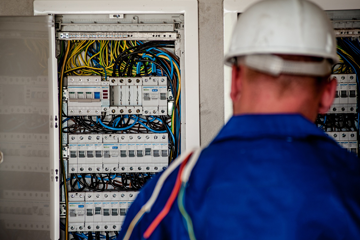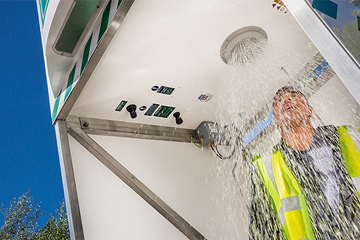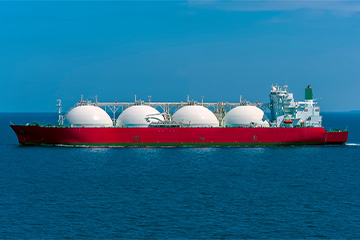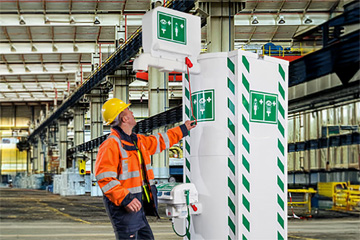Enquiry List () (0)
- Sep 6, 2018

Don’t Let Your Emergency Safety Shower Short Circuit
Keep Emergency Showers and Eyewash Stations Away from Electrical Panels and Equipment
The ANSI standard specifies that the safety shower and eye wash station location is on the same level as the relevant hazard. It must be accessible by workers within 10 seconds (approximately 55 feet or 16.8 meters) of an incident occurring. There should also be no obstructions in the path to get to the safety shower. But what if the ideal safety shower and eye wash station location is next to an electrical power source or electric equipment?Did you know that you can meet the ANSI Z358.1 standard for safety showers and still be unsafe? It is possible to be so focused on meeting the standard that you miss some very serious risks right next to your emergency shower and eye wash station location.
RELATED ARTICLE: Emergency Safety Shower and Eye Wash Stations - Are Yours ANSI Compliant?
Don’t Let Your Emergency Shower and Eyewash Station Become a Workplace Hazard
An article by the Institute for Safety and Health Management highlights the importance of situational awareness for preventing accidents and injuries. The idea is to be observant.
- Identify potential hazards around the task at hand.
- Analyze the conditions and the equipment in use locally and nearby.
- Address any risks before an incident occurs.
As an example, an inspection at a power plant identified a safety shower and eye wash unit positioned right next to an open electrical outlet. To make matters worse, there were four or five pieces of equipment plugged in and drawing power at the time.
Activation of this safety shower and eyewash station in the event of an emergency could have caused a short circuit, an electrical fire or even electrocution. Performing routine inspections and audits like this help to find problems before they cause an incident.
SEE ALSO: Servicing/Maintenance for Emergency Safety Showers and Eyewash Stations
Hughes Safety Showers Provides Free Site Surveys for Emergency Shower and Eyewash Stations
Where are your emergency safety showers and eye wash stations situated?Being responsible for employee safety and the availability of safety equipment is a daunting task. Responsible persons should be able to answer these questions at any time:
- Can you guarantee that they are in working order?
- Do you know when they were last inspected?
- Do you have inspection records for five years? Or, can you show evidence of a regular maintenance program?
Hughes offers free site surveys to help answer these questions and identify any shortcomings. Our engineers have extensive experience in site audits across many different industries. We focus on meeting the ANSI criteria, but also on identifying any unsafe conditions – such as proximity to electrical circuits or equipment.
FREE DOWNLOAD: Weekly Activation Test Record
Hughes also helps with how to train your associates and visitors about dangers to pay attention to, suitable safety shower and eye wash station locations, and the proper use of safety shower equipment in the event of an emergency.
RELATED ARTICLE: Making the Right Choices – Emergency Safety Showers and Eye/Face Washes
Requirements for Safety Shower and Eye Wash Station Locations
Surprisingly, recommended distances between a safety shower and an electrical panel, outlet or equipment are not directly covered by OSHA or ANSI.
RELATED ARTICLE: What are the OSHA Safety Shower Requirements?
However, there are other standards that can help. The National Electric Code (NEC), also known as NFPA 70, regulates electrical outlets in residential, commercial, and industrial occupancies. It specifies special outlets with Ground Fault Circuit Interrupters (GFCI) for use in wet areas. This includes any area where an electrical appliance could come in to contact with water, such as bathrooms and kitchens. The GFCI cuts off power to the appliance when it registers a leakage of current (as would occur if some of the current was conducted through a person or water, instead of through the appliance).
Although this standard does not directly apply to outdoor industrial applications, it is wise to follow in any environments where water and electricity could mix.
In general, it is good practice to avoid locating an emergency shower or eyewash station within splash range of any electrical source, like a panel, socket, extension cable or live equipment.
FREE DOWNLOAD: ANSI Tech Guide
Contact Hughes Safety Showers for a Site Inspection or Technical Advice
Hughes Safety Showers conducts free site surveys to highlight concerns and recommend solutions for emergency safety showers and eye wash stations. Download our free ANSI guide or contact our technical support to find out more.
References
- Occupational Health and Safety. Understanding the ANSI Z358.1-2014 Standard for Plumbed and Portable Eyewash Stations
- Institute for Safety and Health Management. Situational Awareness: The Often-Ignored Hazard Control












